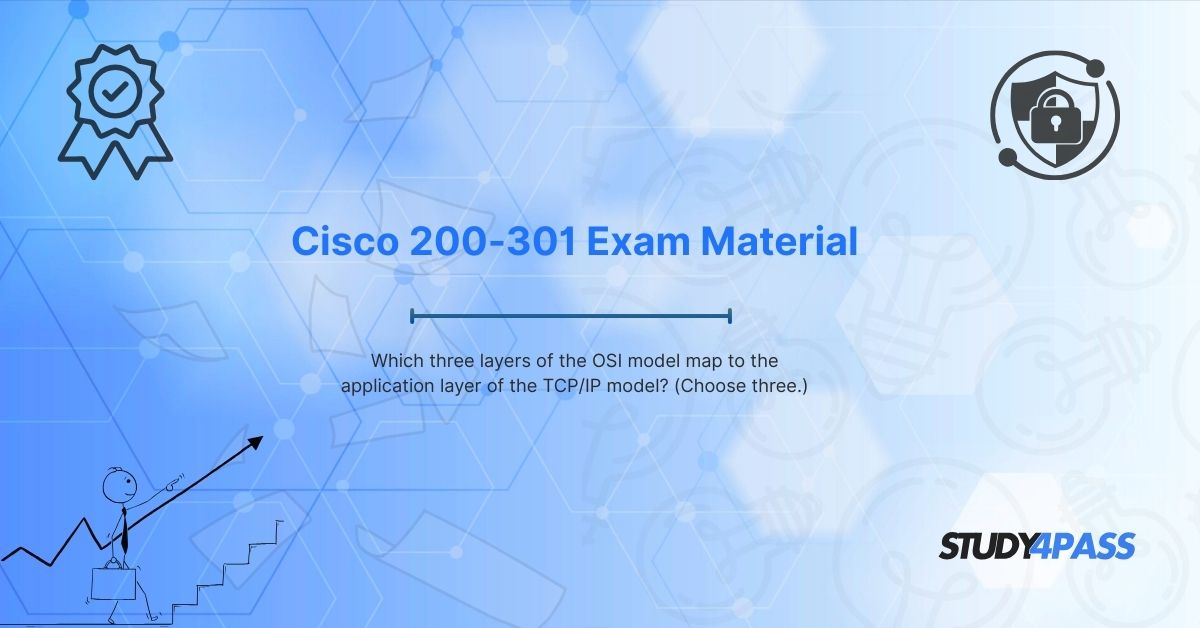Introduction
The Open Systems Interconnection (OSI) model and the Transmission Control Protocol/Internet Protocol (TCP/IP) model are two fundamental frameworks used in networking. While the OSI model consists of seven layers, the TCP/IP model is streamlined into four layers. One of the key differences between these models is how their layers correspond to each other.
In this article, we will explore which three layers of the OSI model map to the application layer of the TCP/IP model—a crucial concept for the Cisco Certified Network Associate (CCNA) 1 v7 Course Final Exam. Additionally, we will discuss the significance of this mapping in networking and how platforms like Study4Pass can help students master these concepts effectively.
Understanding the OSI and TCP/IP Models
1. The OSI Model
The OSI (Open Systems Interconnection) model is a seven-layer conceptual framework that standardizes network communication. Each layer has a specific function:
- Physical Layer (Layer 1) – Deals with the physical connection between devices (e.g., cables, switches).
- Data Link Layer (Layer 2) – Ensures error-free data transfer between nodes (e.g., MAC addressing).
- Network Layer (Layer 3) – Handles routing and logical addressing (e.g., IP addressing).
- Transport Layer (Layer 4) – Manages end-to-end communication (e.g., TCP and UDP).
- Session Layer (Layer 5) – Establishes, maintains, and terminates connections.
- Presentation Layer (Layer 6) – Translates data into a readable format (e.g., encryption, compression).
- Application Layer (Layer 7) – Provides network services directly to user applications (e.g., HTTP, FTP).
2. The TCP/IP Model
The TCP/IP model is a four-layer model that serves as the foundation of the internet:
- Network Access Layer – Combines OSI’s Physical and Data Link layers.
- Internet Layer – Corresponds to OSI’s Network layer (e.g., IP).
- Transport Layer – Matches OSI’s Transport layer (e.g., TCP, UDP).
- Application Layer – Encompasses OSI’s Session, Presentation, and Application layers.
Mapping the OSI Layers to the TCP/IP Application Layer
The Application Layer of the TCP/IP model is a broad layer that incorporates the functionalities of three OSI layers:
1. Session Layer (Layer 5 of OSI)
- Function: Manages sessions between applications, establishing, maintaining, and terminating connections.
- Examples: NetBIOS, RPC (Remote Procedure Call).
- Why it Maps to TCP/IP Application Layer: The TCP/IP model does not have a separate session layer; instead, session management is handled within the Application Layer (e.g., HTTP cookies maintain session states).
2. Presentation Layer (Layer 6 of OSI)
- Function: Translates, encrypts, and compresses data for proper interpretation.
- Examples: SSL/TLS (encryption), JPEG/MPEG (data formatting).
- Why it Maps to TCP/IP Application Layer: The TCP/IP model integrates data formatting and encryption within the Application Layer (e.g., HTTPS combines HTTP with SSL/TLS).
3. Application Layer (Layer 7 of OSI)
- Function: Provides network services directly to end-user applications.
- Examples: HTTP, FTP, SMTP, DNS.
- Why it Maps to TCP/IP Application Layer: The TCP/IP Application Layer directly uses these protocols for user applications.
Thus, the Session, Presentation, and Application layers of the OSI model collectively map to the Application Layer of the TCP/IP model.
Why This Mapping Matters for the CCNA Exam?
Understanding how the OSI and TCP/IP models correlate is essential for:
- Troubleshooting networks (identifying where issues occur).
- Protocol analysis (knowing which layer a protocol operates at).
- Network design (ensuring compatibility between different systems).
For the CCNA 1 v7 Course Final Exam, questions may test:
- Which OSI layers correspond to the TCP/IP Application Layer?
- How protocols like HTTP, FTP, and DNS fit into these models?
- The role of encryption (Presentation Layer) in the TCP/IP model.
How Study4Pass Helps You Master These Concepts?
Preparing for the CCNA exam requires a deep understanding of networking fundamentals. Study4Pass is an excellent resource for students because it offers:
- Comprehensive Study Guides – Detailed explanations of OSI and TCP/IP models.
- Practice Exams – Simulated CCNA questions to test your knowledge.
- Interactive Learning Tools – Flashcards, quizzes, and video tutorials.
- Expert Tips – Strategies to tackle exam questions effectively.
By using Study4Pass, you can reinforce your understanding of how the OSI and TCP/IP layers map to each other, ensuring you’re well-prepared for the CCNA 1 v7 Final Exam.
Conclusion
The Session, Presentation, and Application layers of the OSI model map to the Application Layer of the TCP/IP model. This mapping is crucial for networking professionals and is a key topic in the CCNA certification.
By leveraging resources like Study4Pass, students can gain a solid grasp of these concepts, ensuring success in their exams and future networking careers.
Final Answer:
The three OSI layers that map to the TCP/IP Application Layer are:
- Session Layer (Layer 5)
- Presentation Layer (Layer 6)
- Application Layer (Layer 7)
For more CCNA exam preparation, visit Study4Pass today!
Special Discount: Offer Valid For Limited Time “CCNA 200-301 Latest Exam Prep Practice Tests”
Actual Exam Questions For Cisco's 200-301 Exam Format.
Sample Questions for Cisco 200-301 Topics
1. Which three layers of the OSI model map to the application layer of the TCP/IP model? (Choose three.)
A) Physical
B) Session
C) Transport
D) Presentation
E) Data Link
F) Application
2. The application layer of the TCP/IP model corresponds to which of the following OSI model layers? (Select three.)
A) Network
B) Session
C) Transport
D) Presentation
E) Application
3. Which OSI model layers are combined into the TCP/IP application layer? (Choose three.)
A) Physical
B) Session
C) Network
D) Presentation
E) Application
4. In the TCP/IP model, the application layer encompasses which three OSI layers?
A) Data Link, Network, Transport
B) Session, Presentation, Application
C) Physical, Data Link, Network
D) Transport, Session, Presentation
5. Which of the following is not part of the OSI layers that map to the TCP/IP application layer?
A) Session
B) Presentation
C) Application
D) Transport


